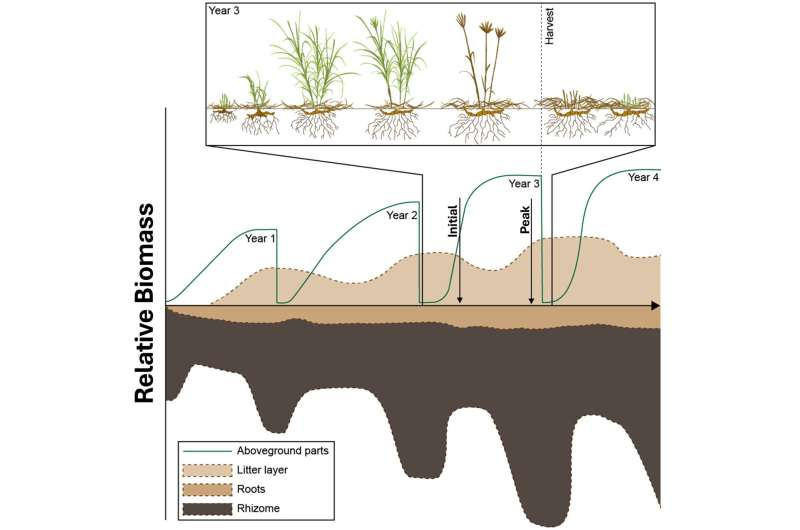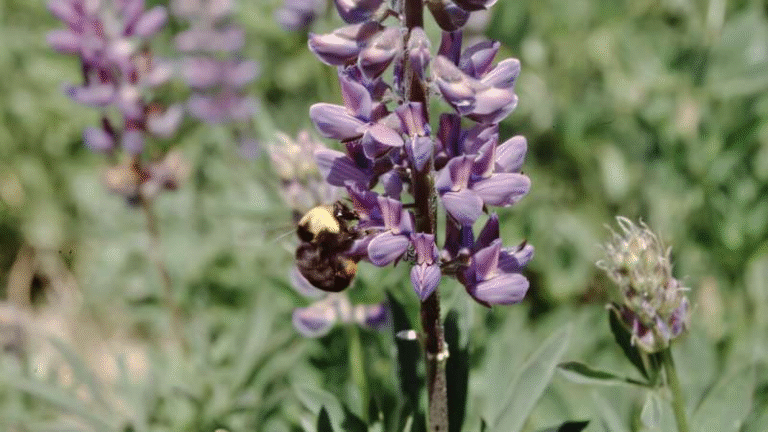Aboveground Growth, Not Roots, Drives Productivity in Miscanthus × giganteus

A new study from researchers at the University of Illinois Urbana-Champaign’s Center for Advanced Bioenergy and Bioproducts Innovation (CABBI) has found that for the perennial bioenergy crop Miscanthus × giganteus, it’s the aboveground growth — not the belowground roots and rhizomes — that primarily determines how much total biomass the plant produces.
This finding reshapes how scientists and bioenergy modelers understand net primary productivity (NPP) — the total carbon captured by plants through photosynthesis and stored in plant tissue. Miscanthus × giganteus (often shortened to M × g) is a sterile hybrid grass known for its massive yields and potential as a bioenergy crop. By distinguishing which part of the plant contributes most to productivity, the study helps researchers better estimate the crop’s carbon sequestration potential and improve agroecosystem models used to predict energy crop performance.
Why Study Miscanthus × giganteus?
M × g is a sterile hybrid perennial grass, a cross between Miscanthus sinensis and Miscanthus sacchariflorus. It’s valued as a high-yielding, low-input biomass crop that can grow on marginal land with minimal fertilizer or irrigation. Because it stores carbon both above and below ground, it’s been studied intensively for its potential role in reducing greenhouse gas emissions and providing a renewable feedstock for biofuels and bioproducts.
Understanding how this plant divides its productivity between shoots (aboveground) and roots or rhizomes (belowground) is key for two main reasons:
- Aboveground biomass determines bioenergy yield — the part harvested for fuel or processing.
- Belowground biomass affects long-term soil carbon storage, which is important for carbon sequestration and climate mitigation.
Until now, the relative contributions of these two parts to the plant’s overall productivity hadn’t been clearly measured in mature stands across different sites and nitrogen conditions.
Study Goals and Design
The research team, led by Theodore Hartman and colleagues from CABBI, set out to directly measure the net primary productivity of mature M × g plants and to evaluate how nitrogen fertilization, location, and sampling methods affect those estimates.
They wanted to answer key questions:
- How much carbon does M × g take up each year in both shoots and roots?
- Does nitrogen fertilizer change how the plant allocates its growth above or below ground?
- How much variation exists between sites and sampling approaches?
To do this, researchers collected biomass samples from multiple field sites: three in Iowa and one in Illinois. Each site had plots with three nitrogen application rates — from zero nitrogen (0 N) to high fertilization (224 kg N ha⁻¹).
The scientists measured aboveground and belowground biomass twice during the growing season — once during early growth and once near peak biomass — to estimate total productivity over the year.
Measuring Aboveground and Belowground Growth
The belowground sampling was one of the most technically challenging aspects of the study. The team used 1 × 1 meter quadrats to collect data. Within each quadrat, they took:
- One “in-clump” core (directly inside the plant clump), and
- One “beside-clump” core (just outside the main clump),
each to a depth of 30 cm to capture the rhizomes and roots. In some plots, they also performed complete excavations to compare results.
By measuring biomass at two key times in the season, the researchers were able to calculate net primary productivity — the change in total biomass (above + below ground) over time.
They also compared core sampling versus full excavation methods to see which gave more consistent results. Interestingly, the combination of in-clump and beside-clump core samples produced averages statistically similar to the excavation results, but with higher variability between replicates.
What the Researchers Found
The numbers paint a clear picture. Across all sites and treatments:
- Aboveground NPP ranged from 15.4 Mg dry matter (DM) ha⁻¹ yr⁻¹ to 36.4 Mg DM ha⁻¹ yr⁻¹.
- Belowground NPP ranged from 4.4 Mg DM ha⁻¹ yr⁻¹ to 19.6 Mg DM ha⁻¹ yr⁻¹.
- On average, aboveground productivity accounted for 68.7% of total NPP.
- Root-to-shoot ratios at peak biomass dropped with nitrogen application — from 1.9 in unfertilized plots (0 N) to 0.89 in highly fertilized plots (224 N).
In simple terms, more nitrogen made the plants grow more aboveground tissue (stems and leaves) and relatively less root mass. This means fertilization shifts how the plant allocates its energy — prioritizing quick top growth over root development.
The team also found that aboveground productivity, rather than belowground, was the main source of variation in total NPP across sites and nitrogen levels.
What It Means for Carbon Sequestration
This finding has big implications for carbon cycle modeling and climate policy. Many models assume a fixed root-to-shoot ratio for perennial crops, but this research shows that ratio actually depends on site conditions and fertilizer management.
If nitrogen fertilization increases aboveground growth while reducing root allocation, there’s a potential trade-off:
- Higher nitrogen → higher yields and energy output
- Lower nitrogen → more root growth and possibly better long-term carbon storage in soil
Understanding this balance will be key for designing management strategies that maximize both bioenergy output and carbon sequestration.
Why Aboveground Productivity Dominates
The dominance of aboveground growth in total productivity likely comes from the physiology of M × g. As a C4 grass, it uses an efficient photosynthetic pathway that allows it to convert sunlight and carbon dioxide into biomass with high efficiency — particularly in leaves and stems exposed to sunlight.
These large, fast-growing shoots capture and store carbon rapidly during the growing season. Meanwhile, belowground tissues like rhizomes serve primarily for storage and overwintering, rather than for continuous carbon accumulation.
Because aboveground growth responds quickly to environmental and management changes, it naturally introduces more variability in overall productivity from one site or year to another.
Broader Context: Miscanthus and Bioenergy
Miscanthus × giganteus has been at the forefront of bioenergy research for over two decades. It’s a sterile hybrid, meaning it doesn’t spread invasively, and once established, it can live for more than 15 years.
It can grow on marginal or low-fertility soils, making it an attractive alternative to annual crops like corn. Studies have shown that M × g can produce up to 40 tons of dry biomass per hectare per year in favorable conditions.
Its high yield, low fertilizer needs, and ability to improve soil structure make it one of the most promising second-generation bioenergy crops. Unlike first-generation crops (like corn for ethanol), M × g doesn’t compete directly with food production.
However, the sustainability of this crop depends heavily on how it’s managed. Too much nitrogen, for instance, can increase greenhouse gas emissions and reduce belowground carbon storage. That’s why understanding how nitrogen influences productivity and carbon partitioning — as this study does — is so valuable.
Data and Modeling Contributions
Beyond the findings themselves, this study produced a detailed dataset of biomass, carbon, and nitrogen concentrations in both above- and belowground plant parts. This dataset, publicly available through the Illinois Data Bank, provides valuable empirical input for agroecosystem and earth-system models that simulate carbon cycling in perennial bioenergy systems.
Such models are crucial for predicting how crops like Miscanthus will behave under different management strategies, soil types, and climate scenarios.
Key Takeaways
- Aboveground productivity is the main driver of variability in total net primary productivity (NPP) for Miscanthus × giganteus.
- Nitrogen fertilization strongly affects carbon allocation: more N means higher shoot growth and a lower root-to-shoot ratio.
- Site conditions and management practices influence total productivity, meaning that modeling efforts must account for regional variability.
- Belowground biomass is still significant — up to 19.6 Mg DM ha⁻¹ yr⁻¹ in some cases — and contributes to soil carbon storage, though it’s less variable than aboveground growth.
- For bioenergy and climate models, accurate estimation of aboveground productivity is crucial, but belowground data remain essential for long-term carbon accounting.
Funding and Research Context
The research was supported by the U.S. Department of Energy through CABBI and the U.S. Department of Agriculture (USDA) Agriculture and Food Research Initiative. The study was published in GCB Bioenergy (2025), with authors from multiple departments at the University of Illinois.
Their work adds another piece to the puzzle of how we can produce renewable energy crops sustainably — optimizing both yield and environmental benefit.
Research Reference:
Aboveground Rather Than Belowground Productivity Drives Variability in Miscanthus × giganteus Net Primary Productivity – GCB Bioenergy (2025)





